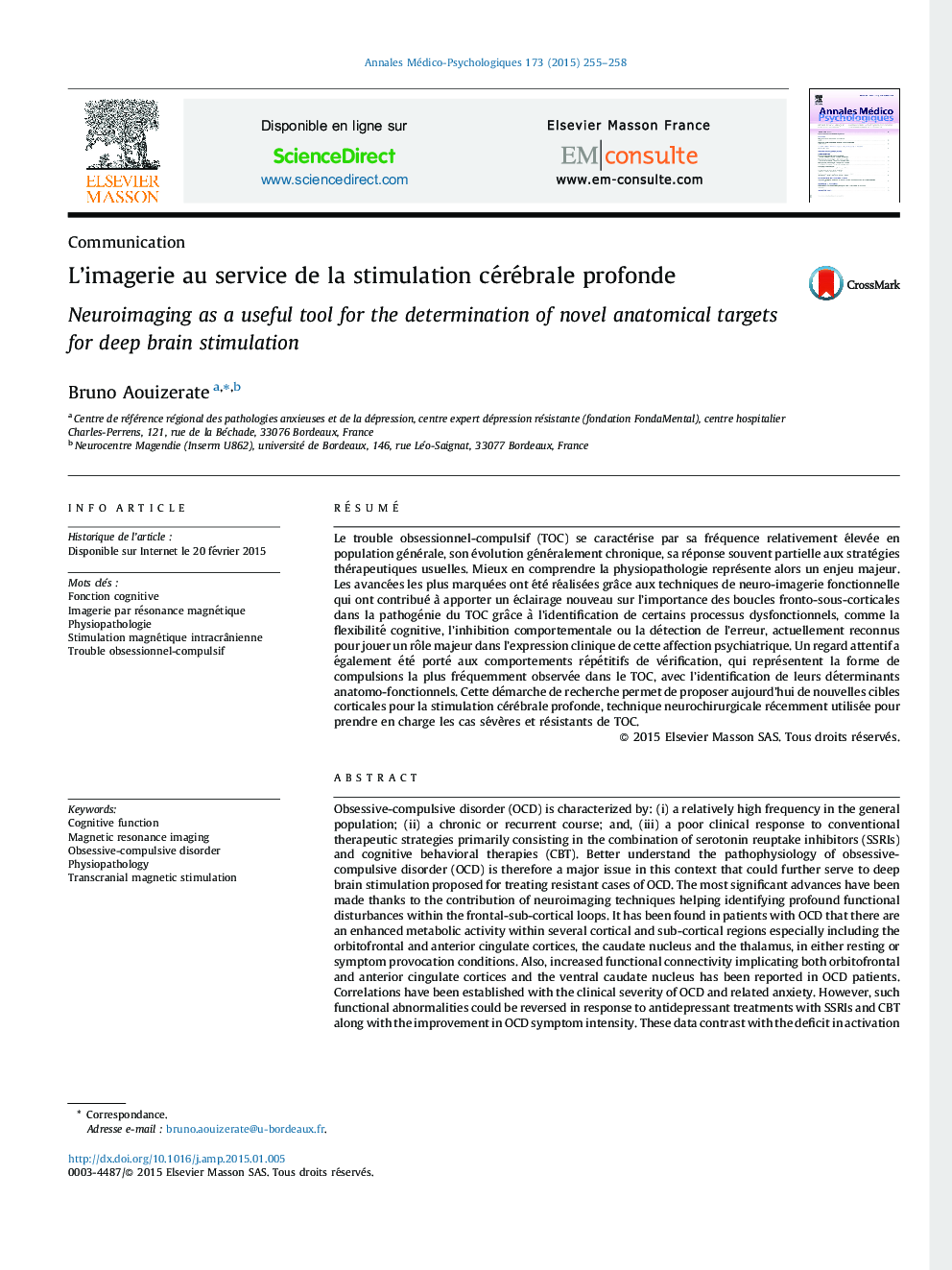| کد مقاله | کد نشریه | سال انتشار | مقاله انگلیسی | نسخه تمام متن |
|---|---|---|---|---|
| 314679 | 534717 | 2015 | 4 صفحه PDF | دانلود رایگان |

RésuméLe trouble obsessionnel-compulsif (TOC) se caractérise par sa fréquence relativement élevée en population générale, son évolution généralement chronique, sa réponse souvent partielle aux stratégies thérapeutiques usuelles. Mieux en comprendre la physiopathologie représente alors un enjeu majeur. Les avancées les plus marquées ont été réalisées grâce aux techniques de neuro-imagerie fonctionnelle qui ont contribué à apporter un éclairage nouveau sur l’importance des boucles fronto-sous-corticales dans la pathogénie du TOC grâce à l’identification de certains processus dysfonctionnels, comme la flexibilité cognitive, l’inhibition comportementale ou la détection de l’erreur, actuellement reconnus pour jouer un rôle majeur dans l’expression clinique de cette affection psychiatrique. Un regard attentif a également été porté aux comportements répétitifs de vérification, qui représentent la forme de compulsions la plus fréquemment observée dans le TOC, avec l’identification de leurs déterminants anatomo-fonctionnels. Cette démarche de recherche permet de proposer aujourd’hui de nouvelles cibles corticales pour la stimulation cérébrale profonde, technique neurochirurgicale récemment utilisée pour prendre en charge les cas sévères et résistants de TOC.
Obsessive-compulsive disorder (OCD) is characterized by: (i) a relatively high frequency in the general population; (ii) a chronic or recurrent course; and, (iii) a poor clinical response to conventional therapeutic strategies primarily consisting in the combination of serotonin reuptake inhibitors (SSRIs) and cognitive behavioral therapies (CBT). Better understand the pathophysiology of obsessive-compulsive disorder (OCD) is therefore a major issue in this context that could further serve to deep brain stimulation proposed for treating resistant cases of OCD. The most significant advances have been made thanks to the contribution of neuroimaging techniques helping identifying profound functional disturbances within the frontal-sub-cortical loops. It has been found in patients with OCD that there are an enhanced metabolic activity within several cortical and sub-cortical regions especially including the orbitofrontal and anterior cingulate cortices, the caudate nucleus and the thalamus, in either resting or symptom provocation conditions. Also, increased functional connectivity implicating both orbitofrontal and anterior cingulate cortices and the ventral caudate nucleus has been reported in OCD patients. Correlations have been established with the clinical severity of OCD and related anxiety. However, such functional abnormalities could be reversed in response to antidepressant treatments with SSRIs and CBT along with the improvement in OCD symptom intensity. These data contrast with the deficit in activation within various cortical areas, such as the ventrolateral prefrontal cortex, which was observed during the instrumental tasks specifically exploring either cognitive flexibility or behavioral inhibition. Importantly, this lack of cortical activation was associated with impaired behavioral performances in both OCD patients and unaffected first-degree relatives. However, overactivation within the supplementary motor area has been described, though assumed not to be sufficient to compensate the deterioration of behavioral inhibition observed in OCD patients. Hyperactivity was also found within the dorsal and rostral anterior cingulate cortex of the OCD patients in high-conflict conditions, especially when they have responded correctly to the given instruction, therefore reflecting the high level of uncertainty that drives them. Finally, repetitive checking behaviors represent the most frequently observed forms of compulsions in OCD patients. When placed in a potential situation of unrestricted repetitive checking, OCD patients experiencing daily checking compulsions show a greater number of verification and a longer response time for choice before checking than control subjects. Also, external error signals or checking behaviors have no impact on the degree of uncertainty, as evinced by an unchanged activity within the ventrolateral prefrontal cortex of OCD patients, when the choice is made at the subsequent trial. Taken together, these findings have contributed to shed new light on the importance of the cortico-sub-cortical loops in the pathogenesis of OCD by identifying some dysfunctional processes recognized today to play a major role in the clinical expression of OCD. They also offer the advantage to propose novel anatomical targets for neurosurgical procedures such as deep brain stimulation that is now considered as a promising therapeutic strategy for the management of resistant OCD.
Journal: Annales Médico-psychologiques, revue psychiatrique - Volume 173, Issue 3, March 2015, Pages 259–262